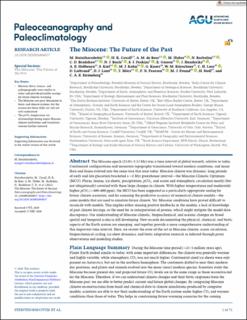| dc.contributor.author | Steinthorsdottir, Margret | |
| dc.contributor.author | Coxall, Helen | |
| dc.contributor.author | De Boer, Agatha | |
| dc.contributor.author | Huber, Matthew | |
| dc.contributor.author | Barbolini, Natasha | |
| dc.contributor.author | Bradshaw, C. | |
| dc.contributor.author | Burls, N. | |
| dc.contributor.author | Feakins, Sarah | |
| dc.contributor.author | Gasson, E | |
| dc.contributor.author | Henderiks, Jorijntje | |
| dc.contributor.author | Holbourn, Ann E | |
| dc.contributor.author | Kiel, Steffen | |
| dc.contributor.author | Kohn, M | |
| dc.contributor.author | Knorr, Gregor | |
| dc.contributor.author | Kürschner, Wolfram Michael | |
| dc.contributor.author | Lear, Caroline H. | |
| dc.contributor.author | Liebrand, Diederik | |
| dc.contributor.author | Lunt, Daniel J | |
| dc.contributor.author | Mörs, Thomas | |
| dc.contributor.author | Pearson, Paul | |
| dc.contributor.author | Pound, Matthew J. | |
| dc.contributor.author | Stoll, Heather | |
| dc.contributor.author | Stromberg, C | |
| dc.date.accessioned | 2021-08-20T10:31:40Z | |
| dc.date.available | 2021-08-20T10:31:40Z | |
| dc.date.created | 2021-04-28T13:23:01Z | |
| dc.date.issued | 2021 | |
| dc.identifier.issn | 2572-4517 | |
| dc.identifier.uri | https://hdl.handle.net/11250/2770538 | |
| dc.description.abstract | The Miocene epoch (23.03–5.33 Ma) was a time interval of global warmth, relative to today. Continental configurations and mountain topography transitioned toward modern conditions, and many flora and fauna evolved into the same taxa that exist today. Miocene climate was dynamic: long periods of early and late glaciation bracketed a ∼2 Myr greenhouse interval—the Miocene Climatic Optimum (MCO). Floras, faunas, ice sheets, precipitation, pCO2, and ocean and atmospheric circulation mostly (but not ubiquitously) covaried with these large changes in climate. With higher temperatures and moderately higher pCO2 (∼400–600 ppm), the MCO has been suggested as a particularly appropriate analog for future climate scenarios, and for assessing the predictive accuracy of numerical climate models—the same models that are used to simulate future climate. Yet, Miocene conditions have proved difficult to reconcile with models. This implies either missing positive feedbacks in the models, a lack of knowledge of past climate forcings, or the need for re-interpretation of proxies, which might mitigate the model-data discrepancy. Our understanding of Miocene climatic, biogeochemical, and oceanic changes on broad spatial and temporal scales is still developing. New records documenting the physical, chemical, and biotic aspects of the Earth system are emerging, and together provide a more comprehensive understanding of this important time interval. Here, we review the state-of-the-art in Miocene climate, ocean circulation, biogeochemical cycling, ice sheet dynamics, and biotic adaptation research as inferred through proxy observations and modeling studies. | en_US |
| dc.language.iso | eng | en_US |
| dc.publisher | AGU | en_US |
| dc.relation.uri | https://agupubs.onlinelibrary.wiley.com/doi/10.1029/2020PA004037 | |
| dc.rights | Attribution-NonCommercial-NoDerivatives 4.0 Internasjonal | * |
| dc.rights.uri | http://creativecommons.org/licenses/by-nc-nd/4.0/deed.no | * |
| dc.title | The Miocene: The Future of the Past | en_US |
| dc.type | Journal article | en_US |
| dc.type | Peer reviewed | en_US |
| dc.description.version | publishedVersion | en_US |
| dc.rights.holder | Copyright 2020 The Authors | en_US |
| dc.source.articlenumber | e2020PA004037 | en_US |
| cristin.ispublished | true | |
| cristin.fulltext | original | |
| cristin.qualitycode | 2 | |
| dc.identifier.doi | 10.1029/2020PA004037 | |
| dc.identifier.cristin | 1906971 | |
| dc.source.journal | Paleoceanography and Paleoclimatology | en_US |
| dc.identifier.citation | Paleoceanography and Paleoclimatology. 2021, 36, e2020PA004037 | en_US |
| dc.source.volume | 36 | en_US |

